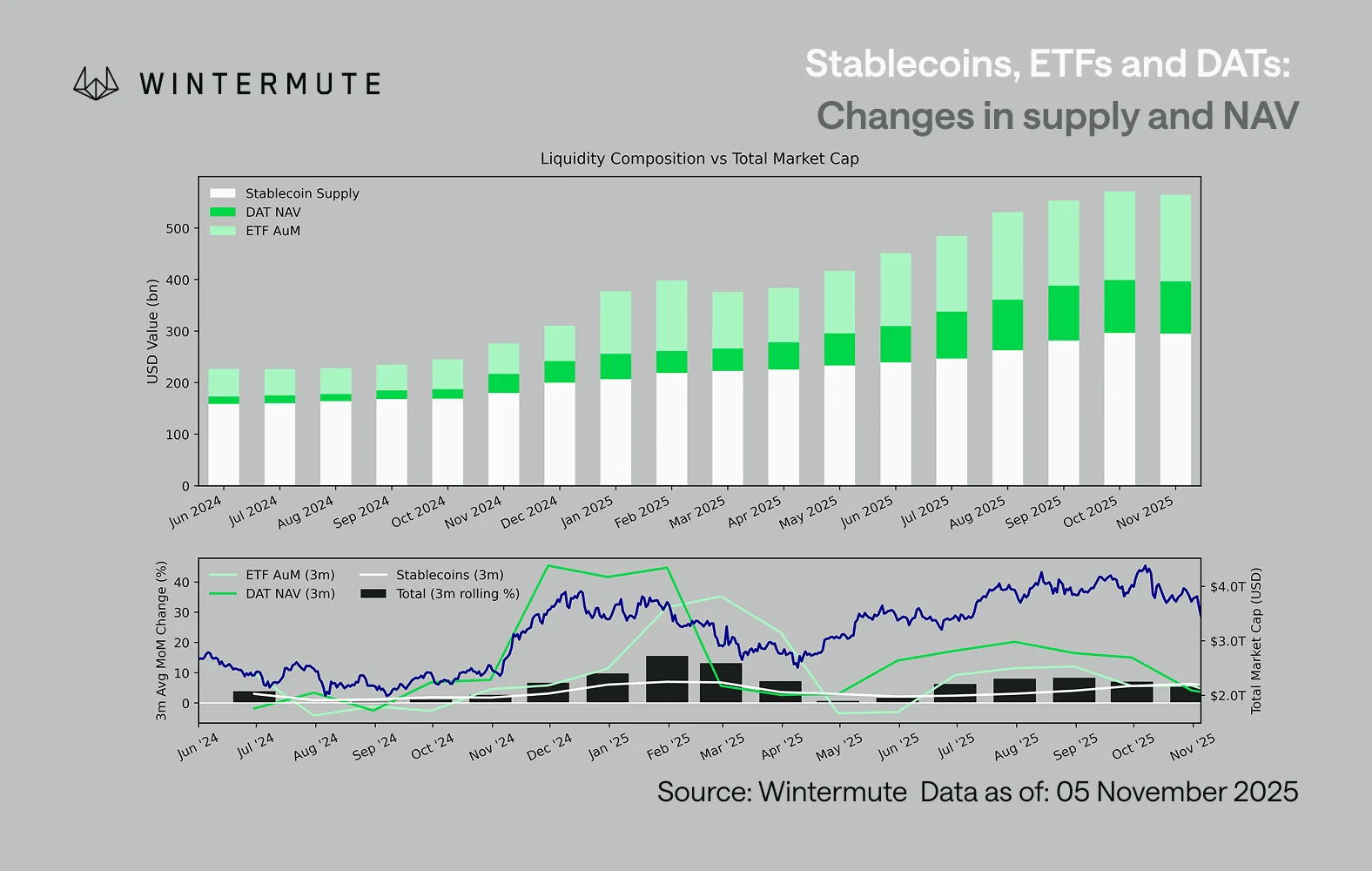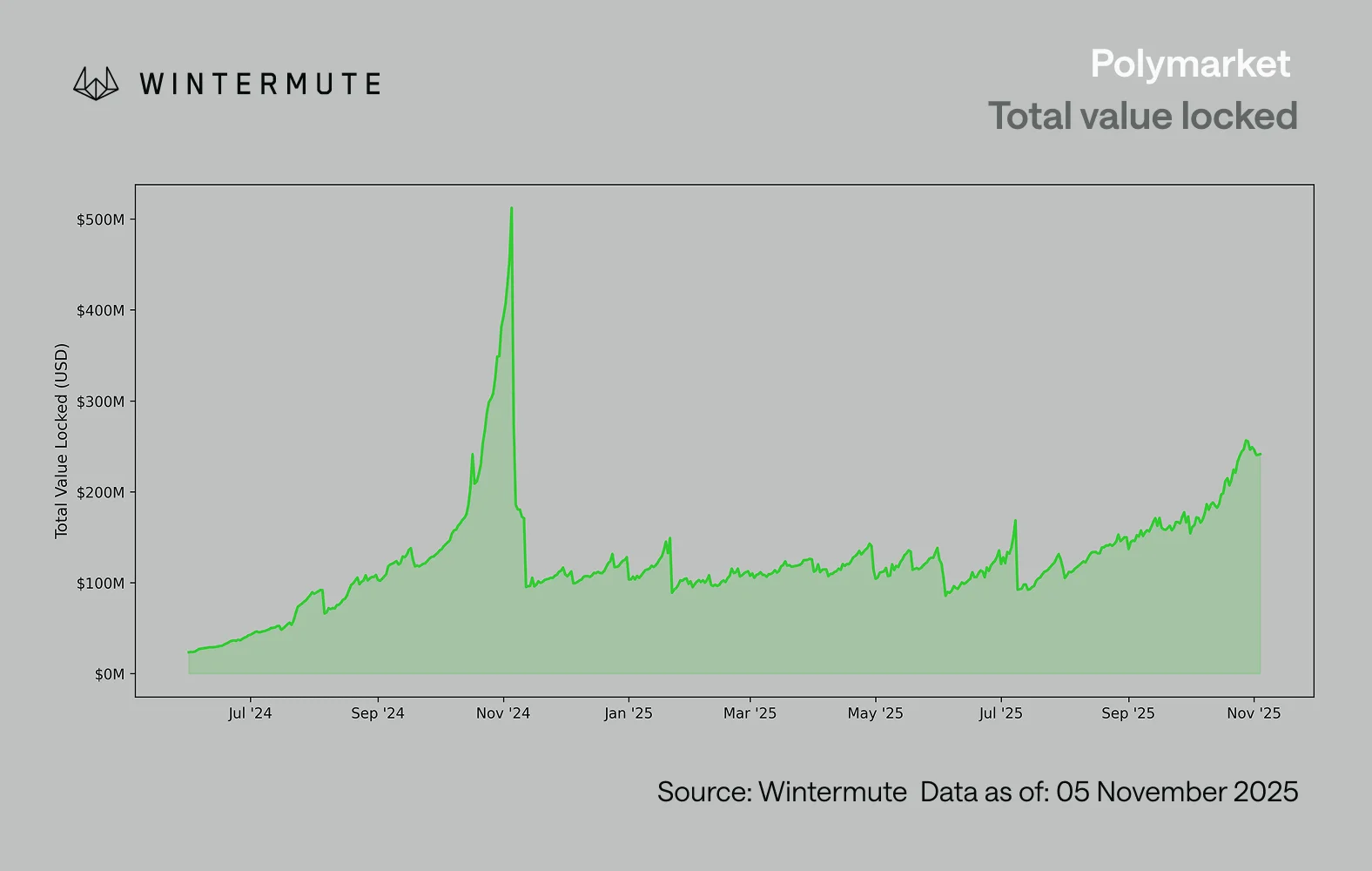Wintermute Market Outlook: Fund inflows stagnate, market enters a phase of zero-sum game.
- 核心观点:加密市场流动性放缓,进入存量博弈阶段。
- 关键要素:
- 稳定币、ETF、DAT三大资金流入同步减弱。
- 高利率使资金滞留国债市场。
- 市场资金内部轮动,缺乏外部增量。
- 市场影响:短期波动加剧,反弹持续性受限。
- 时效性标注:短期影响
This article is from: Wintermute
Compiled by Odaily Planet Daily ( @OdailyChina ); Translated by Azuma ( @azuma_eth )

Key Conclusions
First, liquidity dominates the crypto market cycle, while inflows from stablecoins, ETFs, and DAT (Digital Asset Vault) are slowing.
Second, global liquidity remains ample, but the high SOFR rate keeps funds in short-term government bonds (T-bills) rather than flowing into the crypto market.
Third, the crypto market is in a "self-sustaining" phase – funds circulate internally until new external funds re-enter the market.
The dominant role of liquidity
Liquidity often dominates each cycle in the cryptocurrency market. In the long run, adoption may determine the direction of the cryptocurrency industry's story, but what truly drives price changes is the direction of capital flows.
Over the past few months, the momentum of these capital inflows has slowed significantly. The rate of capital flow into the ecosystem through the three main channels—stablecoins, ETFs, and digital asset vaults (DAT)—has weakened in tandem, shifting the cryptocurrency market from an expansion phase to one supported by existing funds.
While technology adoption is important, liquidity is the real key driver of market cycles. This is not just a matter of market depth, but also of capital availability. When global money supply expands or real interest rates fall, excess liquidity inevitably seeks out risky assets, and crypto assets have historically (especially during the 2021 cycle) been one of the biggest beneficiaries.
In previous cycles, liquidity primarily flowed into digital assets through the issuance of stablecoins, which was the core fiat currency entry point. However, as the market matures, three major liquidity funnels have gradually formed, determining the path for new capital to enter the crypto market:
- Digital Asset Vaults (DATs) : Tokenized funds and yield structures used to connect traditional assets with on-chain liquidity.
- Stablecoins : On-chain form of fiat currency liquidity, serving as underlying collateral for leverage and trading activities.
- ETFs : Provide traditional financial institutions and passive funds with access to BTC and ETH exposure.
Combining the assets under management (AUM) of ETFs, the net asset value (NAV) of DATs, and the number of stablecoins issued can serve as a reasonable indicator for measuring the total capital inflow into digital assets.
The chart below illustrates the changes in these components over the past 18 months. The bottom chart shows that this overall change is highly correlated with the overall market capitalization of digital assets—prices rise as funds flow in more rapidly.

Which pathway has seen a slowdown in inflows?
A key message reflected in the chart is the significant weakening of inflow momentum for DAT and ETFs. These two paths performed strongly in Q4 2024 and Q1 2025, with a brief rebound in early summer, but momentum has since dissipated. Liquidity (M2) is no longer flowing into the crypto ecosystem as naturally as it did at the beginning of the year. Since the beginning of 2024, the total size of DAT and ETFs has grown from approximately $40 billion to $270 billion, while the stablecoin supply has more than doubled from approximately $140 billion to $290 billion. This shows structural growth, but also a clear "plateau."
It is important to observe the slowdown in different paths because each path reflects a different source of liquidity: stablecoins reflect the inherent risk appetite of the crypto market; DAT reflects institutional demand for yield assets; and ETFs reflect the allocation trends of traditional financial funds. The simultaneous slowdown of all three indicates that new capital deployment is generally decelerating, rather than just rotating between products.
Zero-sum game market
Liquidity has not disappeared; it is merely circulating within the system rather than continuously expanding.
From a broader macroeconomic perspective, overall economic liquidity (M2) outside the crypto market has not stagnated. While higher SOFR rates may constrain liquidity in the short term—making cash yields more attractive and keeping funds in the Treasury market—the world remains in an easing cycle, and the US quantitative easing (QT) has officially ended. The structural backdrop remains supportive; it's just that liquidity is currently flowing more towards other risk expressions, such as the stock market.

With reduced external capital inflows, market dynamics have become closed. Funds are rotating more frequently between large-cap and altcoin sectors, creating a game-the-up (PVP) situation. This explains why rallies are always short-lived and why market breadth is shrinking even with stable total assets under management. Currently, the surge in market volatility stems primarily from a chain reaction of liquidations rather than from a sustained trend.
Looking ahead, any substantial recovery in any liquidity pathway—whether it's the re-issuance of stablecoins, renewed popularity of ETFs, or a rebound in DAT size—would signify a return of macro liquidity to the digital asset sector.
Until then, the crypto market will remain in a "self-sustaining" phase, with funds circulating internally rather than growing through compound interest.



